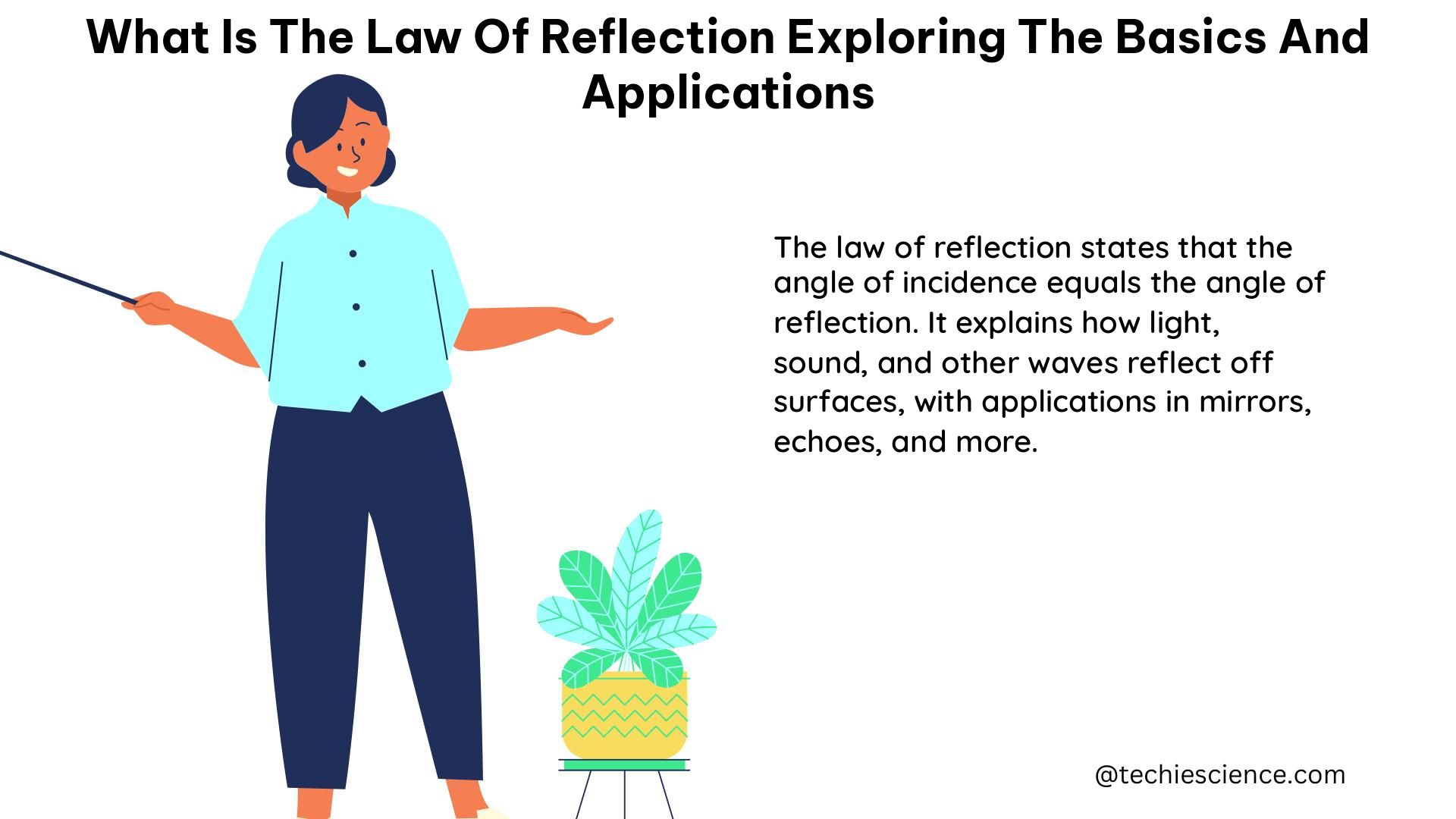The law of reflection is a fundamental principle in physics that describes how light behaves when it reflects off a smooth surface. This law states that the angle of incidence is equal to the angle of reflection, and all three – the incident ray, the reflected ray, and the normal to the surface at the point of incidence – lie in the same plane.
Understanding the Law of Reflection
Angle of Incidence and Angle of Reflection
The angle of incidence is the angle between the incident ray and the normal to the surface, while the angle of reflection is the angle between the reflected ray and the normal. According to the law of reflection, these two angles are equal, as shown in the following equation:
Angle of incidence = Angle of reflection
This means that the reflected ray bounces off the surface at the same angle as the incident ray hits it.
Regular and Irregular Reflection
There are two types of reflection: regular reflection and irregular reflection.
Regular Reflection:
– Occurs when light reflects off a smooth, flat surface
– Results in a clear, visible image
– Examples: Reflection in a plane mirror, curved mirrors with a smooth surface
Irregular Reflection:
– Occurs when light reflects off a rough surface
– Results in diffuse reflection, where the light is scattered in different directions
– Responsible for the ability to see most illuminated surfaces from any position
– Used in medical fields for diagnosis and optical communications
Plane Mirrors and Curved Mirrors
The law of reflection applies to both plane mirrors and curved mirrors, but the resulting images differ:
- Plane mirrors always produce virtual images, which cannot be collected on a screen.
- Curved mirrors can produce either real or virtual images, depending on the position of the object relative to the mirror.
Applications of the Law of Reflection

The law of reflection has numerous applications in various fields, including:
-
Periscopes: Periscopes used in submarines and other military applications rely on the law of reflection to allow the user to view their surroundings without being seen.
-
Distance Measurement: The reflection of sound and light waves can be used to measure distances accurately, as in the case of sonar and radar systems.
-
Optical Instruments: The law of reflection is fundamental to the operation of various optical instruments, such as cameras, telescopes, and microscopes.
-
Architecture and Design: The principles of reflection are used in the design of buildings, mirrors, and other structures to control the flow of light and create desired lighting effects.
-
Medical Diagnostics: Irregular reflection is used in medical fields, such as in the use of ultrasound imaging for diagnostic purposes.
-
Optical Communications: Irregular reflection is also utilized in optical communication systems, where the scattering of light helps to transmit signals through various media.
Numerical Examples and Calculations
To further illustrate the law of reflection, let’s consider some numerical examples and calculations:
Example 1: Reflection in a Plane Mirror
– Incident angle: 30 degrees
– Angle of reflection: 30 degrees
Example 2: Reflection in a Concave Mirror
– Incident angle: 45 degrees
– Angle of reflection: 45 degrees
Calculation: Determining the Angle of Reflection
Given:
– Angle of incidence: 60 degrees
– Normal to the surface
To find the angle of reflection:
– Angle of reflection = Angle of incidence
– Angle of reflection = 60 degrees
Figures and Diagrams
To better understand the law of reflection, let’s look at some figures and diagrams:
Figure 1: Diagram illustrating the law of reflection
Figure 2: Comparison of regular and irregular reflection
Figure 3: Reflection in plane and curved mirrors
Conclusion
The law of reflection is a fundamental principle in physics that describes the behavior of light when it reflects off a smooth surface. By understanding the concepts of angle of incidence, angle of reflection, regular and irregular reflection, and the applications of this law, you can gain a deeper understanding of the principles of optics and their practical implications.
References
- UCF Pressbooks, “The Law of Reflection,” College Physics, accessed June 20, 2024, https://pressbooks.online.ucf.edu/phy2053bc/chapter/the-law-of-reflection/.
- GeeksforGeeks, “Reflection and Laws of Reflection,” accessed June 20, 2024, https://www.geeksforgeeks.org/reflection-and-laws-of-reflection/.
- BYJU’S, “Laws of Reflection: Definition, Types, Diagrams, differences, Uses,” accessed June 20, 2024, https://byjus.com/physics/laws-of-reflection/.
- Physics Classroom, “The Law of Reflection,” accessed June 20, 2024, https://www.physicsclassroom.com/class/refln/Lesson-1/The-Law-of-Reflection.
- Khan Academy, “Reflection of light,” accessed June 20, 2024, https://www.khanacademy.org/science/physics/light-waves/reflection-of-light/a/the-law-of-reflection.
- HyperPhysics, “Reflection of Light,” accessed June 20, 2024, http://hyperphysics.phy-astr.gsu.edu/hbase/geoopt/refl.html.
- ThoughtCo, “Law of Reflection,” accessed June 20, 2024, https://www.thoughtco.com/law-of-reflection-373223.

The lambdageeks.com Core SME Team is a group of experienced subject matter experts from diverse scientific and technical fields including Physics, Chemistry, Technology,Electronics & Electrical Engineering, Automotive, Mechanical Engineering. Our team collaborates to create high-quality, well-researched articles on a wide range of science and technology topics for the lambdageeks.com website.
All Our Senior SME are having more than 7 Years of experience in the respective fields . They are either Working Industry Professionals or assocaited With different Universities. Refer Our Authors Page to get to know About our Core SMEs.